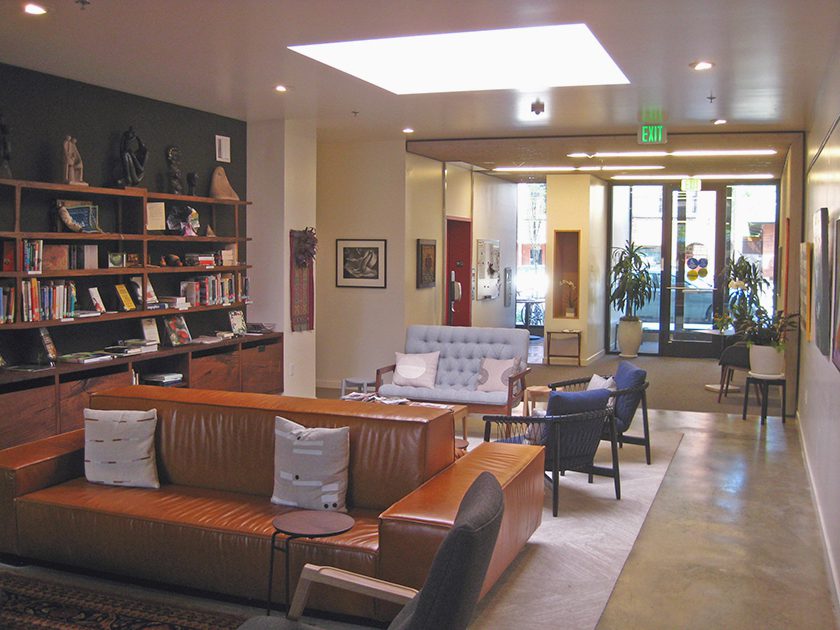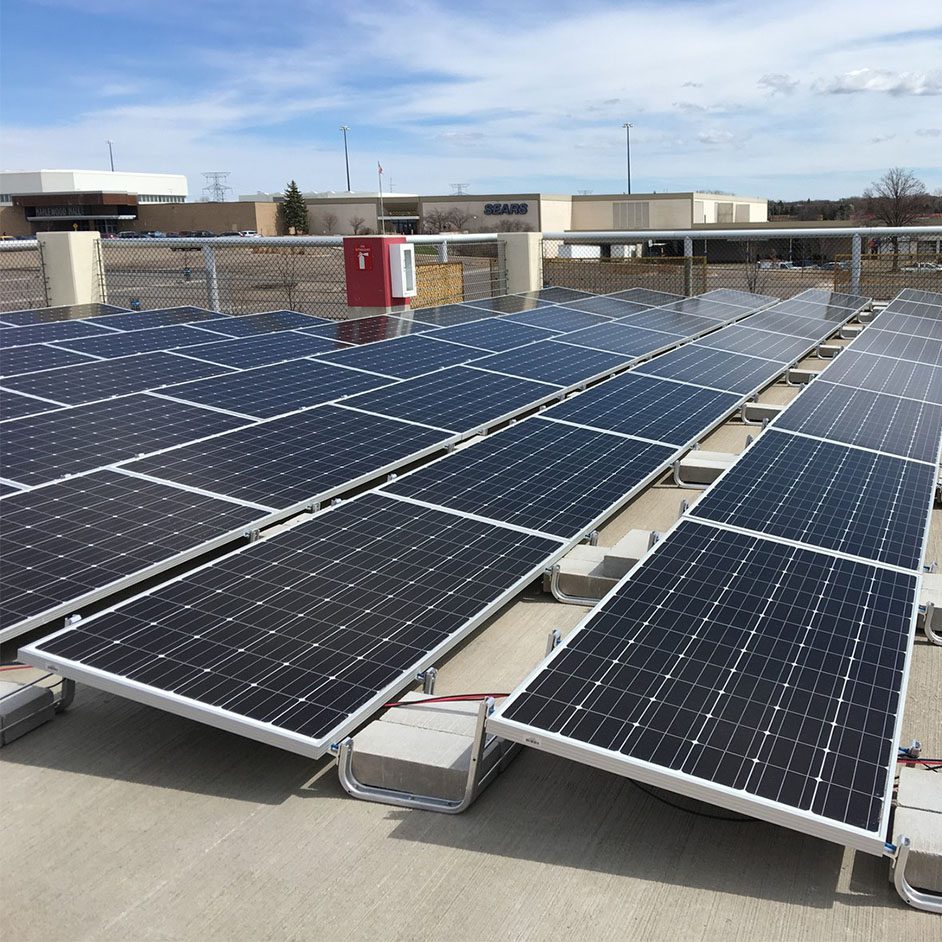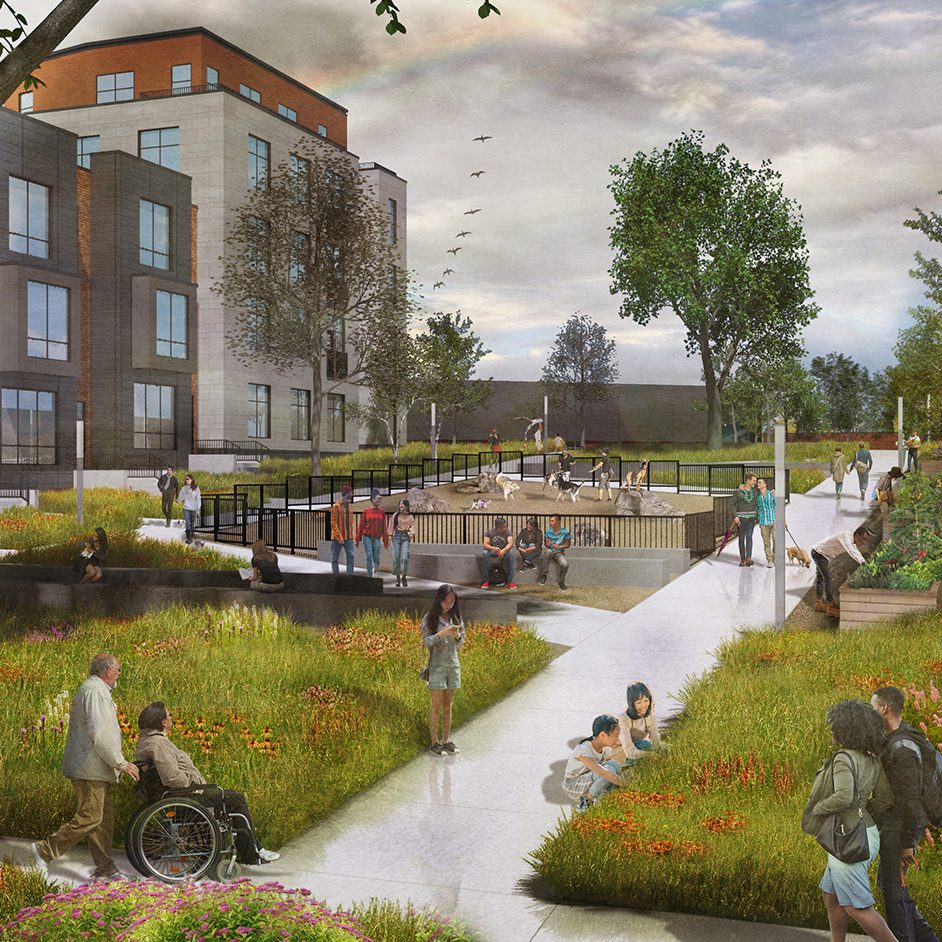“The City is like a large house, and the House is like a small city.” Leon Battista Alberti
In May I was given the opportunity to travel to Portland to attend parts of the Living Futures Conference and to document the recent housing-related developments around the city. One of these sessions featured at the Conference was a tour showcasing a concept of multifamily housing known as ‘cohousing.’ There are many reasons why people may choose to organize and live within a cohousing community, but I am particularly excited about the concept’s potential for shaping more resilient communities.
I toured PDX Commons, a 4-story, 27-unit building that is very much like any other multifamily housing development. Unlike typical forms of housing, cohousing developments tend to be organized around a few common characteristics:
- Relatively dense or compact privately-owned homes or dwelling units organized arounds several or larger common spaces.
- Shared spaces are shaped to encourage frequent group interaction and to support large-group social activities like shared meals or parties.
- Residents collaboratively manage the communal spaces in which they live, rather than hiring an outside management company.
- Designed, intentional community, meaning that the building(s) is typically built incorporating the site context into the social and financial benefits of its design.It’s easy to confuse the concept of cohousing with a housing cooperative or a commune. The former is a form of property ownership irrespective of the type of community housed or engendered, and frequently cooperatives exist without any of the aforementioned characteristics. The latter typically coalesce around a shared philosophy, and most resources in a commune tend to be shared. The easiest way to think about cohousing is as condominium or HOA with a high proportion of common area that is maintained by the residents. More importantly, cohousing is intentionally-designed by its residents to yield the particular benefits they desire from their community.

Because so much emphasis is placed on shared spaces, resident participation and group consensus, a substantial amount of work goes into building the community before an architect is ever selected to design a building for the community. Once the future residents know what kind of spaces they desire and what they hope to get from their future building, the design of the building (or buildings) and its complementary spaces can be designed to engender the community the residents have already started to build. Research has indicated that many individual benefits come from living within a community:
- Increased civic engagement and meaningful living for all ages
- Decreased loneliness and the health impacts connected to loneliness
- Increased independence in aging, resulting from the established social network
- Increased individual control over housing circumstances and needs
- Increased multi-generational interactions allow children to engage and learn from adults other than their parents, and elderly residents can feel purpose in participating in the growth and mentoring of younger residents. Young parents also benefit from built-in day care.
- Holistic self- and communal-wellbeing encouraging greater environmental consciousness and resourcefulness

The cohousing concept isn’t new. Societies around the world have lived in similar situations for thousands of years, but the modern form of cohousing was developed in Denmark in the early 70s. While the model has grown worldwide, it has increased in popularity in recent years as baby-boomers have desired a down-sized, invigorated social life and young families search for flexible and enriched ways to raise children. Newer cohousing developments are more likely to engage LEED and Living Future projects because of this emphasis on generational wellbeing, diversity, and legacy. Because cohousing communities focus decision-making on modes of consensus-building, high-performance buildings are more likely to be successful as a result of the committed buy-in.
As cities large and small continue to grow, designers need to grapple with the challenges posed by limited space and resources, the mental and physical healthiness of city inhabitants, the environmental impact of buildings, and economic diversity in the current paradigm of design and construction. Cohousing may only be small part of the mix of designed solutions to these challenges, but the social, environmental, and financial benefits arising hold a promise of highly-resilient supportive housing in the many positive outcomes of this mode of living.

Cohousing examples:
Daybreak Cohousing, Portland, OR: http://www.daybreakcohousing.org/SiteandDesign.html
Capitol Hill Urban Cohousing, Seattle, WA: https://capitolhillurbancohousing.org/overview/
Silver Sage Village, Boulder, CO : http://silversagevillage.com/look-around/
Vancouver Cohousing, Vancouver, BC: https://vancouvercohousing.com/the-project/
Vashon Cohousing, Vashon, WA : http://vashoncohousing.com/
Mosaic Commons, Berlin, MA: http://www.cohousing.org/Mosaic%20Commons
Additional resources:
The Cohousing Association of the United States: http://www.cohousing.org/what_is_cohousing
UK Cohousing (and research): https://cohousing.org.uk/information/research/
Canadian Cohousing Network: http://cohousing.ca/
Additional reading:
Cohousing: A Contemporary Approach to Housing Ourselves – https://www.abebooks.com/servlet/BookDetailsPL?bi=22851499604&searchurl=tn%3DCohousing%253A%2BA%2BContemporary%2BApproach%2Bto%2BHousing%2BOurselves.%26sortby%3D17%26an%3DMcCamant%252C%2BKathryn%253B%2BDurrett%252C%2BCharles.&cm_sp=snippet-_-srp1-_-title1
Creating Cohousing: Building Sustainable Communities – https://www.newsociety.com/Books/C/Creating-Cohousing
The Senior Cohousing Handbook: A Community Approach to Independent Living – https://www.newsociety.com/Books/S/The-Senior-Cohousing-Handbook-2nd-Edition
CoHousing Cultures: self-organized, community-oriented, and sustainable – https://cohousing-cultures.net/uber-das-buch/?lang=en

